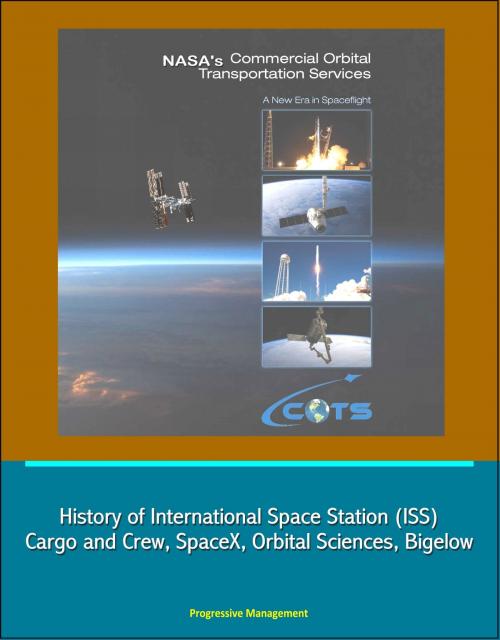NASA's Commercial Orbital Transportation Services: A New Era in Spaceflight - History of International Space Station (ISS) Cargo and Crew, SpaceX, Orbital Sciences, Bigelow
Nonfiction, Science & Nature, Technology, Aeronautics & Astronautics, Science, Physics, Astrophysics & Space Science| Author: | Progressive Management | ISBN: | 9781310894978 |
| Publisher: | Progressive Management | Publication: | June 6, 2014 |
| Imprint: | Smashwords Edition | Language: | English |
| Author: | Progressive Management |
| ISBN: | 9781310894978 |
| Publisher: | Progressive Management |
| Publication: | June 6, 2014 |
| Imprint: | Smashwords Edition |
| Language: | English |
This document provides a history of the NASA Commercial Orbital Transportation Services (COTS) program executed by the Commercial Crew & Cargo Program Office from 2006 to 2013 at the Johnson Space Center. It provides unique insight into the amazing commercial effort that has seen two companies, SpaceX and Orbital Sciences, supply cargo services to the International Space Station (ISS).
Preface * Introduction * Chapter 1: Laying the Foundation * NASA and Industry * Key Concepts * Chapter 2: Concept to Reality * Leadership and Coalescence * Legal Team and Space Act Agreements * Thinking Like an Investor * International Space Station * Foundation Ready * Chapter 3: Competition * Round 1 * Round 2 * Unfunded Space Act Agreements * Chapter 4: Program * Funding * Organization * Operations * Chapter 5: Commercial Partners * Space Exploration Technologies Corp * Rocketplane Kistler * Orbital Sciences Corp * Chapter 6: Collaboration * International Space Station * Federal Aviation Administration * Chapter 7: First Steps Toward Commercial Crew * Commercial Crew Development * Commercial Crew Program * Chapter 8: Legacy * From Contingency to Dependency * The COTS Model: A New Way * Conclusion * Appendix * Acknowledgments * COTS Model for NASA Public-Private Partnerships * Chronology * COTS Oral History Interviews * Bibliography * Endnotes
In May 2012, the SpaceX Dragon made headlines as it became the first commercial spacecraft to deliver cargo to the International Space Station (ISS). In September 2013, NASA saw a second commercial partner, Orbital Sciences Corp., follow with its own resupply mission to the ISS.
These successful missions represented the fruition of six years of intensive work executed under partnership agreements between NASA and the commercial space community—partnerships that both resulted in the availability of cost-effective cargo transportation services for the Agency, and the advancement of the U.S. commercial space industry.
NASA's support was critical to the companies' success. Said Gwynne E. Shotwell, President of the Space Exploration Technologies Corp. (SpaceX), "We would not be the company that we are today without the support of NASA," continuing, "We'd probably be limping along, trying to change the world, but limping instead of running." Orbital President and CEO David W. Thompson echoed the sentiment as he described how NASA was "very helpful in helping us work through various kinds of problems that came up," concluding that "it's been a great relationship."
These partnerships had their origin in 2005, when NASA Administrator Michael D. Griffin was appointed and, with the support of the presidential administration and Congress, allocated a fixed $500 million contribution from NASA's budget for the instigation of commercial transportation capabilities to low-Earth orbit. The new Commercial Crew & Cargo Program Office (C3PO) at the Johnson Space Center (JSC) in Houston, Texas was charged with the task of "stimulating commercial enterprise in space by asking American entrepreneurs to provide innovative, cost-effective commercial cargo and crew transportation services to the [international]space station."
From 2006 to 2013, under the Commercial Orbital Transportation Services (COTS) program managed by C3PO, NASA acted as an investor and advisor with three different and distinct companies in the space transportation industry to promote the development of U.S. space transportation capabilities on the frontier of human exploration.
This document provides a history of the NASA Commercial Orbital Transportation Services (COTS) program executed by the Commercial Crew & Cargo Program Office from 2006 to 2013 at the Johnson Space Center. It provides unique insight into the amazing commercial effort that has seen two companies, SpaceX and Orbital Sciences, supply cargo services to the International Space Station (ISS).
Preface * Introduction * Chapter 1: Laying the Foundation * NASA and Industry * Key Concepts * Chapter 2: Concept to Reality * Leadership and Coalescence * Legal Team and Space Act Agreements * Thinking Like an Investor * International Space Station * Foundation Ready * Chapter 3: Competition * Round 1 * Round 2 * Unfunded Space Act Agreements * Chapter 4: Program * Funding * Organization * Operations * Chapter 5: Commercial Partners * Space Exploration Technologies Corp * Rocketplane Kistler * Orbital Sciences Corp * Chapter 6: Collaboration * International Space Station * Federal Aviation Administration * Chapter 7: First Steps Toward Commercial Crew * Commercial Crew Development * Commercial Crew Program * Chapter 8: Legacy * From Contingency to Dependency * The COTS Model: A New Way * Conclusion * Appendix * Acknowledgments * COTS Model for NASA Public-Private Partnerships * Chronology * COTS Oral History Interviews * Bibliography * Endnotes
In May 2012, the SpaceX Dragon made headlines as it became the first commercial spacecraft to deliver cargo to the International Space Station (ISS). In September 2013, NASA saw a second commercial partner, Orbital Sciences Corp., follow with its own resupply mission to the ISS.
These successful missions represented the fruition of six years of intensive work executed under partnership agreements between NASA and the commercial space community—partnerships that both resulted in the availability of cost-effective cargo transportation services for the Agency, and the advancement of the U.S. commercial space industry.
NASA's support was critical to the companies' success. Said Gwynne E. Shotwell, President of the Space Exploration Technologies Corp. (SpaceX), "We would not be the company that we are today without the support of NASA," continuing, "We'd probably be limping along, trying to change the world, but limping instead of running." Orbital President and CEO David W. Thompson echoed the sentiment as he described how NASA was "very helpful in helping us work through various kinds of problems that came up," concluding that "it's been a great relationship."
These partnerships had their origin in 2005, when NASA Administrator Michael D. Griffin was appointed and, with the support of the presidential administration and Congress, allocated a fixed $500 million contribution from NASA's budget for the instigation of commercial transportation capabilities to low-Earth orbit. The new Commercial Crew & Cargo Program Office (C3PO) at the Johnson Space Center (JSC) in Houston, Texas was charged with the task of "stimulating commercial enterprise in space by asking American entrepreneurs to provide innovative, cost-effective commercial cargo and crew transportation services to the [international]space station."
From 2006 to 2013, under the Commercial Orbital Transportation Services (COTS) program managed by C3PO, NASA acted as an investor and advisor with three different and distinct companies in the space transportation industry to promote the development of U.S. space transportation capabilities on the frontier of human exploration.















